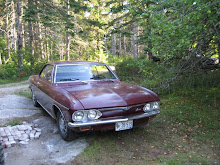The mantra on classic cars is that you love to run them as daily drivers because they're so easy to maintain compared to the complexities of the modern car. Not so fast, please.
First comes the QE I, the Land Rover. Although I swapped out points/rotor/condenser before the Maine Winter Romp in February, the car started to run poorly the following week. Suddenly one morning it absolutely would not idle with the choke pushed in all the way. If you let your foot off the accelerator, the car would stall. It would start right up again, but it would not idle.
So I begged the use of the local electric co-op's garage [my cars provide quite a bit of amusement for the linesmen] and got the QE I indoors. I went immediately for the last thing I did, the points, and checked the gap. Yes, they had closed up a bit. This would usually affect starting, too [it didn't for me], but might be part of the problem. I opened them up, put the distributor back together, and started the car. It still would not idle.
So I started with the fuel filter [no water in the gas] and the little filter at the base of the Weber card. Both looked clean. Then I removed the top of the carb and checked the bowl and jets. There was no grit or water in there, but I sopped up the gas and removed and sprayed out the jets. Usually, this is all you have to do with a Weber, but the absence of grit or goop meant I had to go further. I sprayed out every orifice I could find and the removed the side jet.
This jet had a black sooty film on it, so I sprayed out each orifice and wiped the jet clean. I removed the mixture screw/needle and found the same black soot at its tip. I also saw the same stuff on the carb throat. When I cleaned them all up, and buttoned up the carb, I found the car would idle perfectly. Success!
Ah, no. I drove to my job site and found the car would barely accelerate! Worse yet, it was pinging under load. So the next morning I checked the points again and found the points had been gapped too wide. I adjusted them more carefully and then tried the car one more time. It certainly idled fine and there was no more pinging, but the car still bogged on acceleration - pulling out the chock, even when warm, helped, indicating that the carb was still starved.
Yesterday morning, on the advice of the head tech at Rovers North, I enrichened the mixture to see if acceleration might improve. I haven't driven the car far enough to warm up the engine [no choke] to see if there's any improvement but it seems better when playing with the throttle linkage at the carb.
I also tried to bleed the clutch system as the clutch doesn't seem to work as well as it did once, but the bleeder screw seemed corroded in place. So I sprayed it up with penetrating oil to see if I could loosen it in the future.
The good news - all the tools required for this repair included a flat head screwdriver, a feeler gauge, working eyes and ears. It also required you to think through a diagnostic scheme and effect a solution. The total cost was $0.
The bad news - it couldn't be fixed by simply swapping out a part for a very expensive new one at a shop that gave you free coffee, a tv showing bad programming, and an expensive ride to work.
Ah, I'll accept those tradeoffs any day.
On the even-better side, I dug the Corvair out of its snowbank and found it started perfectly, leaked some oil gently, and drove wonderfully on a short ride to work. What a sweet car!
Subscribe to:
Post Comments (Atom)









No comments:
Post a Comment